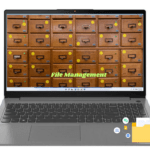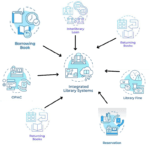The best element to find a specific document in a library is the bibliography. According to Charles Amy Cater, the bibliography is the most efficient element that helps in fulfilling the following objectives.
1. If an individual knows the author, title or subject, he/she can find the book in the library.
2. It is known what kind of collection of a particular author, subject and literature is available in a library.
3. It helps in making the customer’s choice.
The use of bibliography depends on many factors. Such as its usability, completeness, accessibility, modernity, etc. In terms of popularity, bibliography can be of two types,, such as handwritten card bibliography and machine-readable online computer-based bibliography. Both these types of bibliography have their own advantages and disadvantages.

However, the role of the computer as the most significant and important helper of bibliography is unquestionable. With its help, bibliography can be created efficiently and very quickly , by a particular author, subject, or literature, at very low cost. The first online bibliography service was launched in North America at the Ohio College Library Center (OCLC).
The Issues of Online Bibliography System
The issues that need to be focused on in order to arrange a computer-driven online bibliography are –
1. Introduction and maintenance of appropriate bibliographic policies and procedures. For this, specific policies must be followed. Regular review of user opinions and effectiveness must be judged.
2. Establishment and maintenance of local statutory lists or adoption of a standard list.
3. Objects or documents must be reviewed through descriptive or classification and reclassification. In addition, documents can also be reviewed through the preparation of abstracts and primary bibliographic records and their revision and correction.
4. Maintenance of embedded data files and their management.
5. Controlling the bibliography with the help of self-listing, attached documents, statistics, etc.
6. Searching and retrieving information through documents, files, index files, reference files.
7. Preparing various reports, bibliography cards for printing, preparing schedules and creating output with their help.
Various components of an automated bibliographic system:
A number of questions must be answered before developing an active bibliographic system. First, the library’s goals, the skills of its staff, the needs of its customers, etc. need to be properly assessed and reviewed. Based on these, the fields or data parts of the bibliographic record are determined. Second, the question of how the bibliographic system will be entered should be resolved in advance. Third, how the bibliographic system will work should be structured.
Most computer-driven bibliographic systems were invented in the 1960s and 1970s. At that time, bibliographic systems were created using various external media such as cards, film, magnetic plates and books or notebooks. The choice of which media to use depends on the type of media to be used:
A .Easy to understand, fast and error-free;
B .Quick access;
C .Space and cost-effectiveness;
D .Power to insert, add and delete records;etc.
The qualities of an ideal computerized cataloging system are –
a .Similarity of structure;
b .Multiple access facilities;
c .Multiple people can view a card at the same time;
d .Facility of using the same folder for multiple purposes;
e .Customer-specific bibliography can be displayed. For example, if the customer wants, he can view the bibliography in the form of a table or in the MARC format or in the Common Communication Format (CCF) or the Anglo-American Cataloging Rules (ASCR) format.
Currently, the most advanced and popular form of automated computer-driven cA.ataloging system is the Online Public Access Catalog (OPAC). The OPAC system not only provides the customers with a list of all the collections in the library, but also provides various information such as the current status of a particular document, i.e. whether it is in the shelf, whether it has been issued by someone, whether it has been preserved by someone, or if it is issued, when it will be deposited, etc. This OPEC system does not create any barrier between the geographical distance between the library and the customer. Unless there are policy barriers, time also does not have any effect. In this case, the customer can get bibliographic information services 24X7 uninterruptedly.
The following steps are required to develop an automated bibliographic system:
A . Create worksheets;
B . Create machine-readable records with appropriate tags;
C . Verify the accuracy of the final computer-generated record with the machine-readable records;
D . Create a rotating file by adding additional references;
E . Create a dictionary file and cross-reference file by maintaining the connection with the rotating file;
F . Create a subject-based authority file;
G . Publish the bibliography as cards, books or machine-readable.
One of the objectives of an online bibliographic system is to save resources, time and money by providing machine-readable bibliographic data among different libraries and sharing them. For this, descriptive indexing should be standard. If different libraries differ in their descriptive indexing, machine-readable data exchange between libraries will become almost impossible.
Various international standards such as MARC, CCF, ISO 2709 can be used to solve this problem.
How They Work Together in an Automated System:
- Catalogers enter metadata into a system that adheres to either MARC or CCF format.
- The system utilizes ISO 2709 as its foundational structure for storing and transmitting data.
- Automated features, such as copy cataloging, metadata harvesting, and bibliographic conversion, rely on these standards to:
- Validate entries
- Facilitate the importing and exporting of records
- Support international collaboration
- Metadata mapping tools enable crosswalks between different formats, including MARC, CCF, and Dublin Core, among others.
The automated cataloging system, in the library has greatly improved the efficiency and accuracy of organizing library system simplifying the cataloging process, it minimizes manual errors and allows for quick access to information for both staff and users. Overall, this system is essential for modernizing library operations, making resource management more effective and user-friendly.



